#bubalus depressicornis
Explore tagged Tumblr posts
Text

Lowland Anoa | Royale Safaris
66 notes
·
View notes
Text

Lowland anoa Bubalus depressicornis
Observed by roylesafaris, CC BY-NC
62 notes
·
View notes
Text

The lowland anoa (Bubalus depressicornis) is a species of buffalo endemic to Sulawesi.
Anoa species are found on the island of Sulawesi and the nearby island of Buton in Indonesia and live in undisturbed rainforest areas. Aona only live singly or in pairs, rather than in herds like most cattle, except when the cows are about to give birth. Little is known about their life history as well. (Wiki)
2 notes
·
View notes
Text
species found!
Understanding a line of foreshadowing so well that you have to stand up and walk around the house saying “shit shit shit shit shit” until you’re composed enough to go back.
Lowland anoa (Bubalus depressicornis)

listed as Endangered
Understanding a line of foreshadowing so well that you have to stand up and walk around the house saying “shit shit shit shit shit” until you’re composed enough to go back.
246K notes
·
View notes
Text

Bovine Country, Abbott Vanderwagen, 2024
Oil-on-canvas painting
Welcome to Bovine Country, a sanctuary where different bovines roam free and chew their cuds! This oil-on-canvas painting has a spectacular grassland and farm scenery. This farmhouse has a bovine skull on the top center and a silo on the left side. This farm, which is secured by a big white barrier, isn't like most of your "average, everyday" farms, this farm has different species of bovines! And we all know that a group of bovines is called a herd, a father is called a bull, a mother is called a cow, and a offspring is called a calf.
Here is a list of bovines that appear on the painting:
Lowland Anoa (Bubalus depressicornis) — Fact: Lowland anoas are impressive swimmers. They have been spotted swimming long distances to offshore islands
Banteng (also known as the Tembadau) (Bos javanicus) — Fact: The banteng shows extensive sexual dimorphism; adult bulls are generally dark brown to black, larger and more sturdily built than adult cows, which are thinner and usually pale brown or chestnut red.
Plains Bison (Bison bison bison) — Fact: The American bison is the largest land mammal in North America.
Western or Lowland Bongo (Tragelaphus eurycerus eurycerus) — Fact: Bongos are the largest forest antelope.
Cape Buffalo (Syncerus caffer caffer) — Fact: The horns of the cape buffalo are an excellent indication of age and gender. The females and young males do not have the hard shielding that protects the base of the skull in large adult males.
Cattle (Bos taurus) — Fact: They eat hay and grass, which are really hard to digest, so they chew them TWICE! The ruminant technique is called “cud chewing”. Example: A cow chews up the grass and swallows it. The food goes into her stomach where it starts to digest... but then, she then coughs it back up and chews it again before swallowing it for the last time.
Common Eland (also known as the Southern Eland or Eland Antelope) (Taurotragus oryx) — Fact: The eland is the largest African bovid, but the slowest antelope. It can only run at 25 miles per hour, but it can jump 10 feet from a standing start.
Gaur (Bos gaurus) — Fact: It is the largest species among the wild cattle and the bovids.
Gayal (also known as the Drung Ox or the Mithun) (Bos frontalis) — Fact: Gayal are not milked or put to work but given supplementary care while grazing in the woods, until they are ritually slaughtered or killed for local consumption.
Greater Kudu (Tragelaphus strepsiceros) — Fact: They are capable of reaching 690 lbs and of having horns as long as 6 feet.
Nilgai (Boselaphus tragocamelus) — Fact: The nilgai is the biggest of the Asian antelopes.
Lowland Nyala (Tragelaphus angasii) — Fact: They follow baboons, who discard the fruit and leaves that the nyala eats.
Saola (also called the Spindlehorn, the Asian Unicorn, or infrequently, the Vu Quang Bovid) (Pseudoryx nghetinhensis) — Fact: Saolas have only been known to science since 1992!
Sitatunga (also known as the Marshbuck) (Tragelaphus spekii) — Fact: Sitatunga are swamp-dwelling antelopes and excellent swimmers. Their elongated, wide-splayed hooves help them walk on soft terrain such as swamps and marshes.
Yak (also known as the Tartary Ox, the Grunting Ox, the Hairy Cattle, and the Domestic Yak) (Bos grunniens) — Fact: They can withstand frigid temperatures that can reach as low as -40 degrees Fahrenheit.
Add this painting to your collection, because it will make you say "Holy Cow!"
Finished on November 13, 2024
#art#oil on canvas#animals#bovines#lowland anoa#banteng#bison#lowland bongo#cape buffalo#cattle#eland#gaur#gayal#greater kudu#nilgai#lowland nyala#saola#sitatunga#yak#calf#cows#bulls#antelope#bovine skull#bovine country#farm#chewing cud#cud#ruminants#milk
0 notes
Photo

Lowland anoa (Bubalus depressicornis)
Photo by Chien Lee
#fave#lowland anoa#anoa#bubalus depressicornis#bubalus#bubalina#bovini#bovinae#bovidae#pecora#ruminantia#cetruminantia#artiofabula#artiodactyla#euungulata#scrotifera#laurasiatheria#eutheria#mammalia#tetrapoda#vertebrata#chordata
93 notes
·
View notes
Photo

Lowland Anoa (Bubalus depressicornis)
355 notes
·
View notes
Text
Animal of the Day!
Lowland Anoa (Bubalus depressicornis)

(Photo from Flickr)
Conservation Status- Endangered
Habitat- Indonesia
Size (Weight/Length)- 150 kg; 173 cm
Diet- Grasses; Aquatic plants; Fruit; Leaves; Ferns
Cool Facts- The lowland anoa is a type of water buffalo native to Indonesia. They are a relatively small species and tend to be solitary. For a while, it was unknown if the mountain anoa and the lowland anoa were the same species, but recent DNA testing have revealed that they are separate species despite their ability to interbreed. Lowland anoa have been endangered since the 1960s with less than 5000 individuals in the wild. Hunting for their hides and horns is common and habitat loss is destroying the forests they call home. Several zoos are working to increase the genetic diversity of lowland anoa through breeding programs.
Rating- 11/10 (A small, shy guy just wants to be left alone.)
#Animal of the day#Animals#Mammals#Wednesday#March 30#Lowland anoa#biology#science#the more you know#conservation
130 notes
·
View notes
Photo
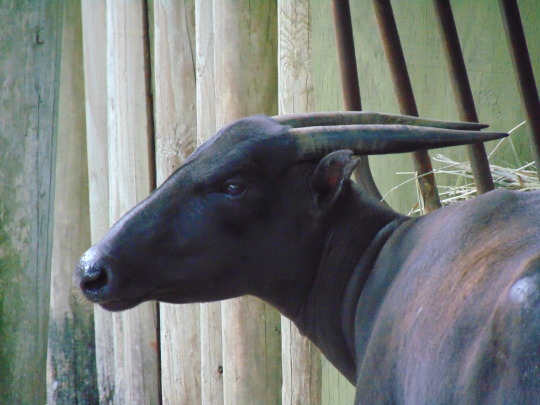
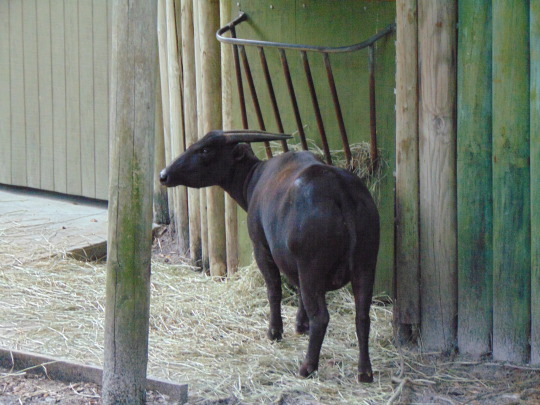
A Lowland Anoa (Bubalus depressicornis) at Zoo Tampa
#my camera fought with me that whole trip#my pix#lowland anoa#bovidae#ungulate#someone called the thing a billy goat and I had A Moment#THE SIGN WAS RIGHT THERE#zoo tampa#I was also with friends so I had limited time to snap pictures so I couldn't wait for poses lol
2 notes
·
View notes
Text
Hewan yang di Lindungi di Masing-Masing Pulau di Indonesia.
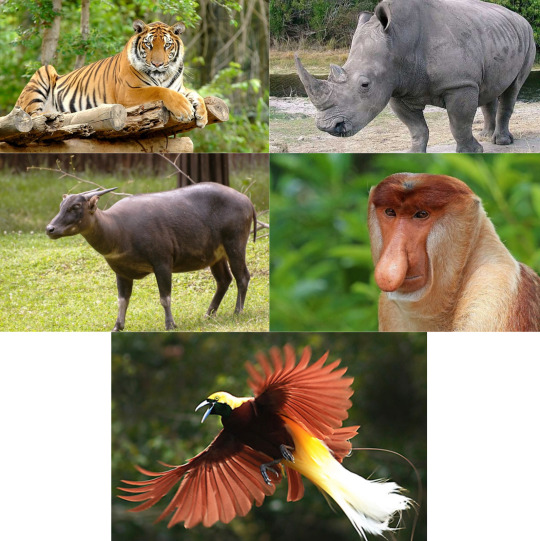
Banyak hewan-hewan endemik dari masing masing pulau di Indonesia. Contohnya, Sumatra dengan harimau nya, Kalimantan dengan orang utan nya, dan yang lainnya. Tapi tahu kah kamu hewan yang di lindungi atau hampir punah di masing-masing pulau di Indonesia? Mari kita bahas.
Harimau Sumatera (Pulau Sumatera).
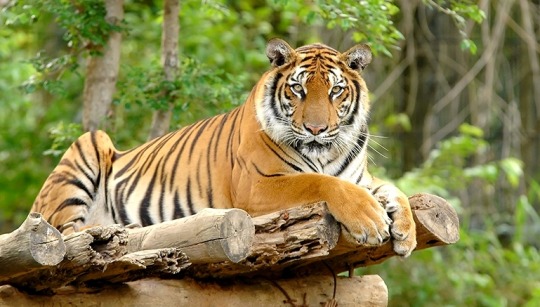
Sumber: kba.one
Harimau Sumatera (Panthera tigris sumatrae) merupakan harimau asli Pulau Sumatera yang memiliki ukuran tubuh lebih kecil dibandingkan jenis harimau lainnya.
Harimau Sumatera jantan memiliki berat sekitar 140 kg, sedangkan harimau Sumatera betina memiliki berat sekitar 91 kg.
Populasi harimau Satwa saat ini hanya tersisa 400-500 ekor sehingga mereka dimasukkan dalam daftar satwa kritis yang terancam punah.
Badak Jawa (Pulau Jawa).
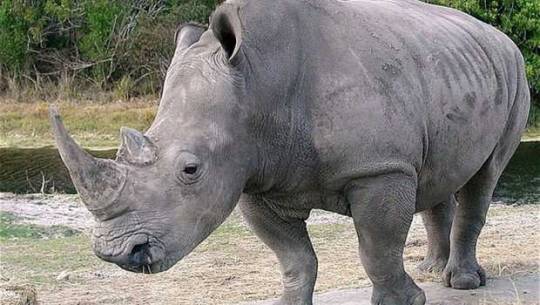
Sumber: beritasatu.com
Badak Jawa (Rhinoceros sondaicus) yang lebih dikenal dengan nama badak bercula satu ini merupakan satwa asli Pulau Jawa. Karena saat ini diperkirakan hanya tersisa 74 spesies, badak bercula satu menjadi salah satu hewan paling langka di Indonesia.
Adapun kemampuan reproduksi yang rendah dan perburuan yang tidak henti-hentinya dilakukan membuat hewan ini menjadi langka. Kini, badak bercula satu tengah berada di bawah perlindungan program konservasi intensif secara in-situ di Taman Nasional Ujung Kulon (TNUK).
Anoa (Pulau Sulawesi).
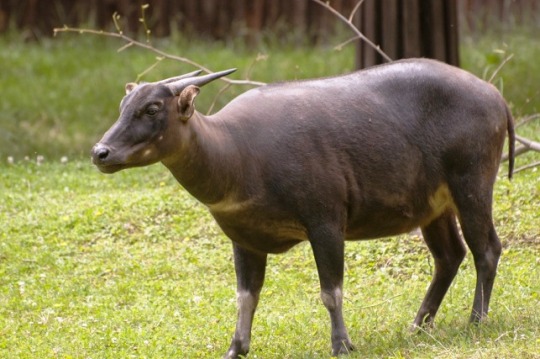
Sumber: Sultrakini.com
Anoa (Bubalus depressicornis) merupakan hewan endemik pulau Sulawesi yang memiliki dua macam spesies, yaitu anoa dataran rendah dan anoa pegunungan.
Anoa termasuk ke dalam hewan yang hampir punah. Mengapa anoa terancam punah? karena kebiasaan masyarakat sekitar yang berburu anoa untuk dikonsumsi hingga diambil bagian kulit dan tanduknya.
Hewan langka ini hidup di dalam hutan sehingga anoa tidak bisa menjadi hewan ternak meski memiliki kesamaan dengan hewan kerbau.
Bekantan (Pulau Kalimantan).
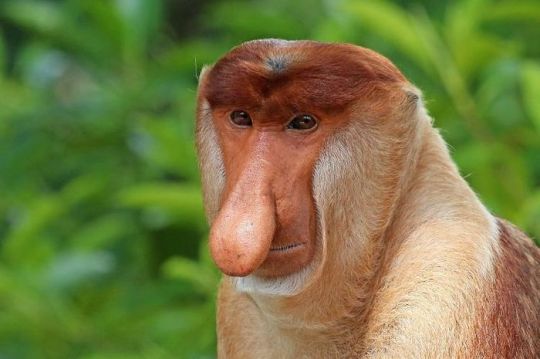
Sumber: prcfindonesia.org
Bekantan (Nasalis larvatus) adalah spesies mamalia yang tergabung dalam kelompok primata dan memiliki habitat di Pulau Kalimantan. Di wilayah Kalimantan Timur, spesies bekantan mendiami wilayah Sungai Hitam di wilayah Samboja, Kutai Kartanegara. Bekantan juga dijuluki monyet berhidung panjang karena memang hidungnya terlihat unik.
Keberadaan bekantan juga sangat memprihatinkan akibat perburuan liar, penebangan hutan, dan perusakan habitat alam liar. Itu sebabnya, spesies bekantan menjadi salah satu spesies hewan yang sangat dilindungi oleh pemerintah Indonesia, bahkan oleh IUCN.
Yang membuat sedih adalah jumlah bekantan yang benar-benar sangat sedikit di alam liar. Menurut data yang ditulis dalam laman Cambridge, jumlah populasi bekantan di alam liar yang hidup mandiri hanya sekitar 300 ekor. Bekantan merupakan spesies yang rentan stres, bahkan mereka bisa mengalami kematian mendadak meskipun sedang berada di tempat penangkaran.
Burung Cendrawasih (Pulau Papua).
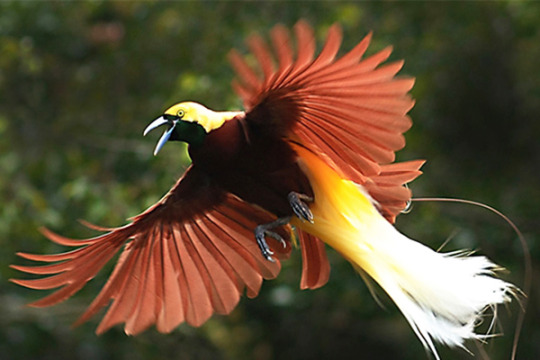
Sumber: kabarpapua.co
Burung Cendrawasih Merah (Paradisaea rubra).Dikenal sebagai burung surga karena keeksotisannya, Cendrawasih Merah corak bulu dominan berwarna merah, dengan aksen hijau, kuning, dan hitam pada bagian kepalanya.
Berdasarkan data, Burung Cendrawasih Merah tergolong ke dalam jenis hewan yang hampir terancam di habitat aslinya, yakni Pulau Waigeo dan Batanta.
Dikutip dari: berbagai sumber.
4 notes
·
View notes
Video
From the archives Via Flickr: Lowland Anoa (Bubalus depressicornis) at Pt. Defiance Zoo
#Animal#Anoa#Bubalus depressicornis#Lowland Anoa#Mammal#Point Defiance Zoo and Aquarium#Zoo#Tacoma#Pierce County#Washington
0 notes
Text
ASEAN oxen symbolizing strength, fragility in biodiversity -ACB chief
#PHinfo: ASEAN oxen symbolizing strength, fragility in biodiversity -ACB chief
ASEAN Heritage Parks Taman Negara National Park in Malaysia and Kaeng Krachan Forest Complex in Thailand host gaurs, one of the largest cattle species in the world. (Photo courtesy of the ASEAN Heritage Parks programme)
CALOOCAN CITY, Feb. 12 (PIA) -- The chief of the ASEAN Centre for Biodiversity (ACB) has highlighted the crucial role of the wild large-horned mammals belonging to the family of bovine species across the ASEAN region in line with the Lunar New Year observance today celebrating the Year of the Ox.
"Today, we also take the opportunity to highlight the crucial role of the wild large-horned mammals belonging to the family of bovine species across the ASEAN region. While their contribution to the people’s nutrition and livelihood are invaluable, the presence of these herbivores contributes to the health and productivity of ecosystems,"said ACB Executive Director Dr. Theresa Mundita S. Lim.
"Apart from adding balance to the food chain as prey for predators, wild ox or wild cattle species help disperse seeds and cycle nutrients in the soil," Lim added.
To recall, the Lunar New Year is widely celebrated in the ASEAN region, particularly in member states where the event is declared a national holiday.
"With optimism and renewed hope for healing and recovery, the ASEAN Centre for Biodiversity joins the ASEAN Member States (AMS) in celebrating the start of the Lunar Year of the Ox," Lim said.
"At this time, we couldn’t help but think of the forest-dwelling kouprey, or grey ox (Bos sauveli) of Cambodia, which is a critically endangered and possibly extinct species. This species remains a mystery as no sightings have been reported since the 1980s. Other bovine species in the ASEAN need not suffer the same fate as the kouprey," she added.
"Wild ox species can still be saved from extinction by implementing species conservation programmes and conservation and protection of the species’ natural habitats. Among these notable endangered species are saola (Pseudoryx nghetinhensis) of Viet Nam and Lao PDR; dwarf buffalo species, anoa (Bubalus depressicornis and B. quarlesi), of the Sulawesi and Buton islands of Indonesia; tamaraw (Bubalus mindorensis), another dwarf buffalo species endemic to the island of Mindoro, Philippines; and banteng (Bos javanicus), which is found across Cambodia, Indonesia, Malaysia (Sabah), Myanmar, Thailand, and Viet Nam. The largest cattle species in the world, the gaur (Bos gaurus) is also found in South and Southeast Asia. However, its population has declined in recent years," the conservation expert enumerated.
Lim said, however, some of the ASEAN Heritage Parks are also home to wild cattles.
"For instance, Mounts Iglit-Baco National Park in the Philippines serves as a refuge for the iconic tamaraws. Gaurs can be seen in Taman Negara National Park in Malaysia and Kaeng Krachan Forest Complex in Thailand. Vu Quang National Park in Vietnam is home to saolas. Kaeng Krachan Forest Complex, on the other hand, hosts a population of banteng," she said.
Lim noted that the ACB and the AMS acknowledge the importance of well-managed protected and conserved areas as critical habitats for endangered species survival and have been supporting the conservation of these species through initiatives under the ASEAN Heritage Parks Programme.
The programme, she said, include assistance in capacity development, patrolling and monitoring, taxonomy, and other work related to ensuring the protection of the region’s most representative wildlife and promoting the nexus between biodiversity and well-being.
"This Year of the Ox, may we embrace the strength that the wild oxen of Southeast Asia symbolise in order to weather and recover from the adversities that we are facing. Let us be reminded that part of this strength is drawn from our harmonious relationship with nature," she said.
"From the ASEAN Centre for Biodiversity, Gōng xǐ fā cái! Chúc Mừng Năm Mới! Happy Lunar New Year!" she added. (PIA NCR)
***
References:
* Philippine Information Agency. "ASEAN oxen symbolizing strength, fragility in biodiversity -ACB chief." Philippine Information Agency. https://pia.gov.ph/news/articles/1066720 (accessed February 12, 2021 at 02:49PM UTC+08).
* Philippine Infornation Agency. "ASEAN oxen symbolizing strength, fragility in biodiversity -ACB chief." Archive Today. https://archive.ph/?run=1&url=https://pia.gov.ph/news/articles/1066720 (archived).
0 notes
Photo


There are no less than 150 million buffaloes in the world of which 145 million live in Asia. Plains anoa (Bubalus depressicornis) and tamarau (Bubalus mindorensis) only survive in Celebes and are threatened with extinction in the near future. The Asian buffalo (Bubalus bubalis) has been largely domesticated by humans for about 3000 BC. African buffaloes are a rapidly evolving group. Among them are the dwarf buffalo (Syncerus caffer nanus) and the large savanna buffalo (Syncerus caffer brachyceros), two subspecies of African buffalo.
0 notes
Text
Lowland anoa / ローランドアノア

Bubalus depressicornis
ローランドアノア インドネシアのスラウェシ島に生息。
Lowland anoa It is found on the island of Sulawesi in Indonesia.
Animalia Chordata Mammalia Artiodactyla Bovidae 動物界 脊椎動物門 哺乳綱 ウシ目 ウシ科 Kanazawa Zoo, Kanagawa, Japan. 金沢動物園@神奈川県横浜市
#Lowland anoa#Bubalus depressicornis#Bovidae#Artiodactyla#Mammal#Kanazawa Zoo#ローランドアノア#ウシ科#ウシ目#哺乳類#金沢動物園
0 notes
Photo

Anoa, Artis IMG_2676 by j.a.kok on Flickr.
2 notes
·
View notes
Photo

Lowland Anoa (Bubalus depressicornis)
225 notes
·
View notes
